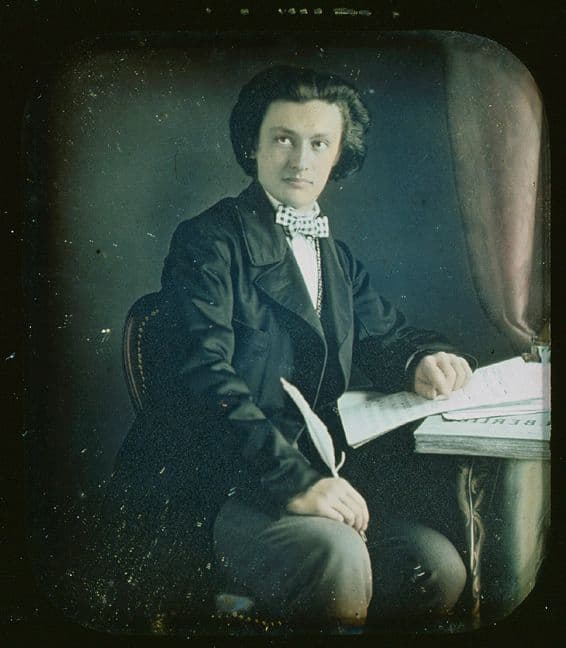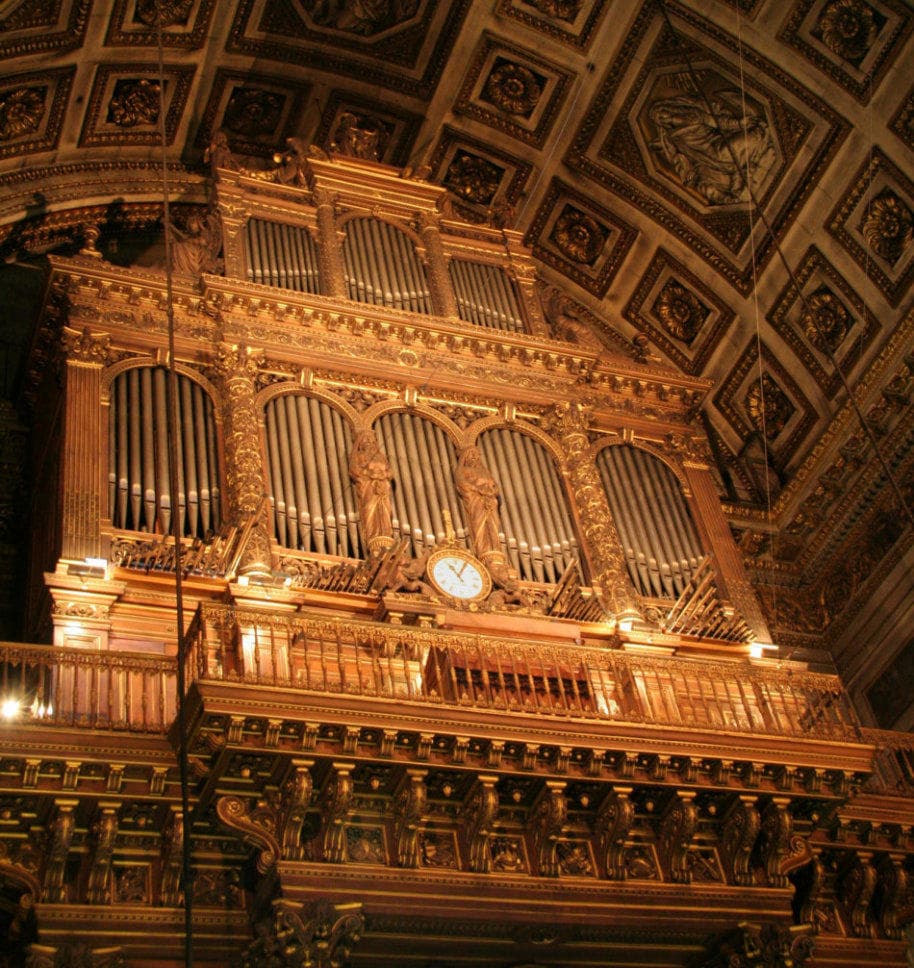Starting with a bow to the great master, Camille Saint-Saëns (1835–1921) opened his 1858 Oratorio de Noël (Christmas Oratorio) with an organ prelude ‘in the style of J.S. Bach’. Written in 1858, the work was recognized in its time for its Bachian echoes. While for us, this would be great praise, in mid-19th century Paris, it was a dismissive comment. The organists knew Bach, but for the public, awash in miles and miles of opera, he was virtually unknown. Saint-Saëns had been appointed organist of the Madeleine church in Paris in 1857, at age 22, a recognition of his skills.

Camille Saint-Saëns in the 1850s
Camille Saint-Saëns: Oratorio de Noël, Op. 12 – Prelude (In the Style of J.S. Bach) (Karin Langebo, harp; Bengt Forsberg, organ; Royal Opera Theater Orchestra; Anders Eby, cond.)
We can equate the beginning of Saint-Saëns’ work with the Sinfonia that starts Bach’s own Christmas Oratorio, BWV 248. The contribution of Saint-Saëns is an updating of Bach’s Baroque style with the precision and sharpness so characteristic of the French composer.

Cavaillé-Coll organ at the Madeleine
Saint-Saëns’ other innovation in the work is to add in a drop of opera: he adds recitatives. The next section of text is not choral, but a setting of the Gospel text about the angel appearing to the shepherds for solo tenor, then solo soprano. It gradually changes from the chant-like tenor setting to a more lyrical soprano line, all above an organ accompaniment. The baritone comes in with the strings before the choir comes in with a Gloria.
Camille Saint-Saëns: Oratorio de Noël, Op. 12 – Recitative: Et Pastores erant – Gloria (Mikaeli Chamber Choir; Karin Langebo, harp; Bengt Forsberg, organ; Royal Opera Theater Orchestra; Anders Eby, cond.)
The following Air, Expectants expectavi, for soprano solo, starts as a duet with the violins. In Bach, we would expect airs like this to be in ABA form, with the opening melody returning at the end, but Saint-Saëns only does this by implication with a brief instrumental code. The B section is a beautiful flowing melody in a very French style.
Camille Saint-Saëns: Oratorio de Noël, Op. 12 – Air: Expectants expectavi Dominum (Karin Langebo, harp; Bengt Forsberg, organ; Royal Opera Theater Orchestra; Anders Eby, cond.)
The following tenor solo, Domine, ego credidi, returns us to a recitative-like setting but quickly changes to real melody. The chorus of women’s voices only enters to emphasize the text.
The following duo for soprano and bass is where we really hear Saint-Saëns spread his melodic wings. Each voice has the chance to soar on flowing melodies.
Camille Saint-Saëns: Oratorio de Noël, Op. 12 – Duet: Benedictus qui venit (Karin Langebo, harp; Bengt Forsberg, organ; Royal Opera Theater Orchestra; Anders Eby, cond.)
The heart of the work is the dramatic core of the work. The text, Quare fremuerunt gentes (Why are the Peoples Afraid?) gives the chorus a chance to take the ‘quare’ (why) as point of exclamation over a scurrying violin line. The answer comes next with chance of dynamics and the declaration of the Gloria, taken from the Mass. The quiet emphasis stills the questioning voices.
Camille Saint-Saëns: Oratorio de Noël, Op. 12 – Quare fremuerunt gentes (Mikaeli Chamber Choir; Karin Langebo, harp; Bengt Forsberg, organ; Royal Opera Theater Orchestra; Anders Eby, cond.)
A flowing trio follows and now the style is less Bach and more French. The expressive harmony, however, is all Saint-Saëns’.
Camille Saint-Saëns: Oratorio de Noël, Op. 12 – Trio: Tecum principium (Karin Langebo, harp; Bengt Forsberg, organ; Royal Opera Theater Orchestra; Anders Eby, cond.)
This is followed by a quartet, then a quintet with chorus. The whole work closes with a return to Bach, both in style and form. Just as Bach closes his oratorios with a chorale, Saint-Saëns closes his work with a chorale-like hymn.
Camille Saint-Saëns: Oratorio de Noël, Op. 12 – Tollite hostias (Mikaeli Chamber Choir; Karin Langebo, harp; Bengt Forsberg, organ; Royal Opera Theater Orchestra; Anders Eby, cond.)
The work was written in less than two weeks by Saint-Saens and it received its premiere on Christmas 1858. We can see that through the work Saint-Saëns gradually increases the performing forces: solo to duet, trio, quartet, quintet, then full chorus to close. It’s a quiet and lyrical work at a time of year when everything can be overstated. Revel in the 19th century French version of Christmas Baroque.
For more of the best in classical music, sign up to our E-Newsletter




This is the second very fine piece I’ve read in 2 days from interlude.hk (the other was a review of Blomstedt’s Bruckner 4 concert in HK several years ago). Kudos — please keep the great work up!